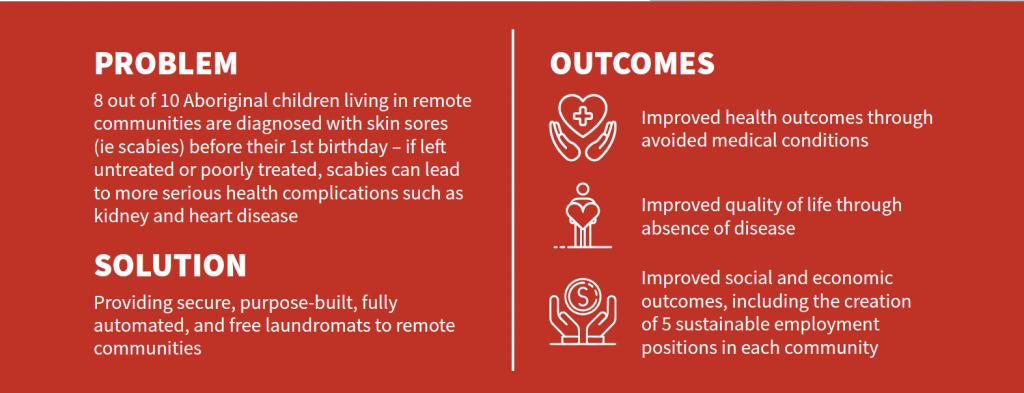How washing helps
Clean bedding, towels and clothes are crucial to being healthy. However, having working washing machines with access to hot water and good detergent is harder than you might think for some people. We believe laundries are a necessary service in communities where overcrowding is common.


The problem
Overcrowding
Overcrowding in the NT is the highest in the country, where up to 56 per cent of people living in state owned and managed Indigenous housing are considered overcrowded (AIHW 2017). The more remote the housing, the more prevalent the overcrowding.
Washing clothes in Aboriginal communities is harder than you might think. A laundry where the machines work, detergent doesn’t run out, and the water is hot is a crucial part of keeping families healthy.
Scabies and skin sores
Scabies is a skin condition caused by a microscopic mite called sarcoptes scabiei. The mites burrow under the skin and makes skin very itchy. It is a common problem in remote NT Aboriginal communities where up to 50 per cent of children and 25 per cent of adults are affected. Eight out of 10 Aboriginal babies who live in remote communities will get scabies before their first birthday. The problem is chronic and widespread and needs urgent attention.
Scratching causes secondary streptococcus and staphylococcus bacterial infections. Streptococcal infections can be associated with inflammation of the kidneys (glomerulonephritis) which increases the risk of kidney failure later in life. Streptococcal infection is also associated with inflammation of the heart (acute rheumatic fever) which can lead to rheumatic heart disease and heart failure. (https://nt.gov.au/wellbeing/health-conditions-treatments/parasites/scabies).
Medication and washing bedding, towels and clothing with detergent, hot water and using a hot dry cycle is important when trying to break the life cycle of the scabies mite.
Rheumatic heart disease (RHD)
A preventable disease, RHD is caused by repeated bouts of rheumatic fever which permanently damage the heart. Children living in overcrowded, unclean houses in rural and remote Aboriginal communities are most at risk.
Shamefully, Australia has some of the highest rates of RHD in the developed world. A laundry with working machines will help to kill the bacteria that causes the infection.
Nasty bacteria
Overcrowding puts strain on the health and wellbeing of all occupants, but there are some particularly nasty bacteria like staph that can be slowed down and even stopped with regular washing of bedding, towels and clothing .
It’s all about repeated infections – overcrowding means people (especially children) are exposed to nasty bacteria over and over again.
Improving sanitation through washing clothes, bedding and towels with detergent, hot water and a hot dry cycle will help to break the cycle of repeat infections.
The solution
Solving the housing crisis in Aboriginal communities is the solution – but in the absence of that, washing is a very important part of the solution to protecting people against scabies which leads to skin sores and after repeated infections, to rheumatic heart disease and kidney disease.
The tragic thing about all these diseases is they are preventable, and in the absence of adequate housing, communities need our help to stay as healthy as they can within the environment they live.
Facilities where the washing machines and dryers work, the detergent doesn’t run out, and the water is hot is a crucial part of keeping families healthy.
